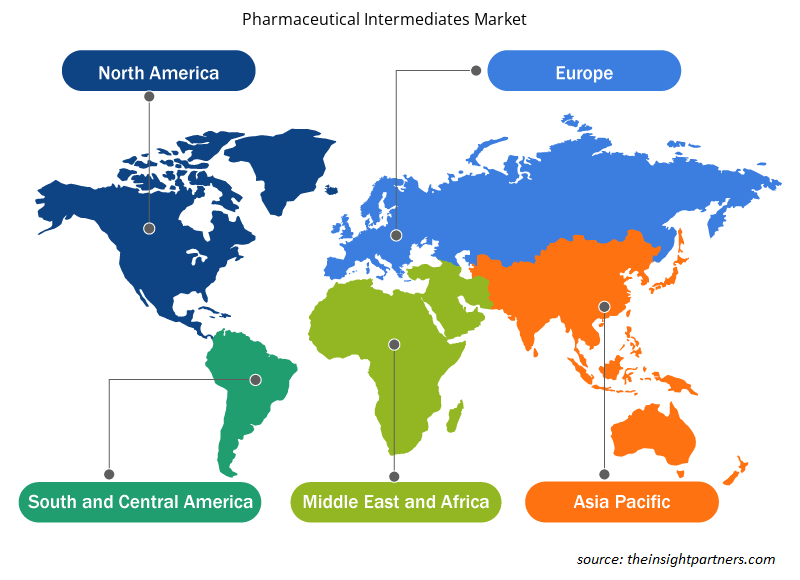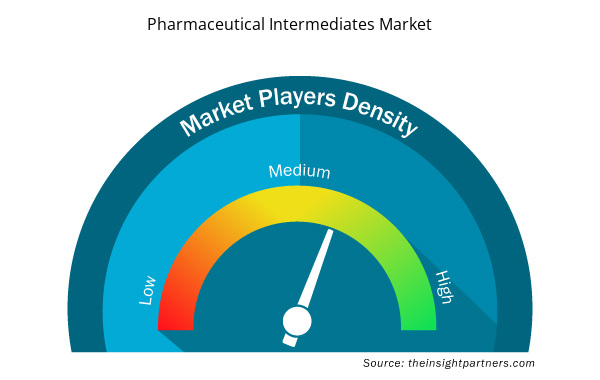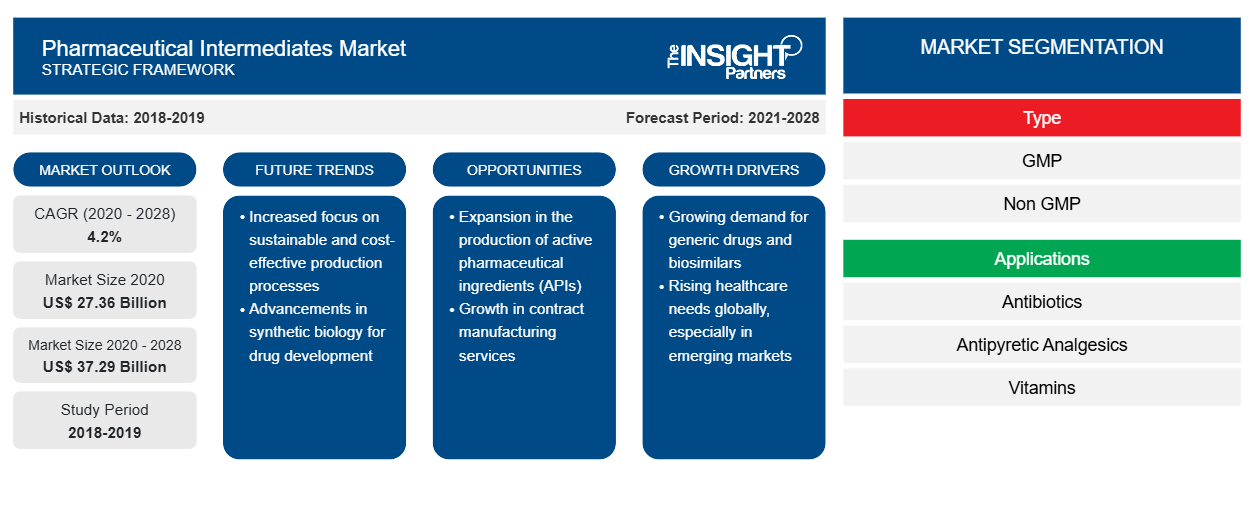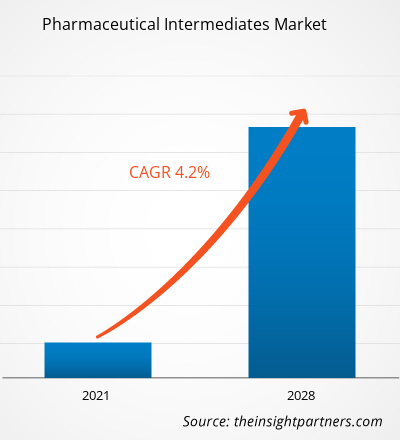Si prevede che il mercato degli intermedi farmaceutici raggiungerà i 37.290,33 milioni di dollari nel 2028, rispetto ai 27.356,70 milioni di dollari del 2020. Si stima che il mercato crescerà con un CAGR del 4,2% dal 2021 al 2028.
Il mercato degli intermedi farmaceutici è stato analizzato in base a tipo, applicazione, canale di distribuzione e regione. Il mercato in base alla regione è segmentato in Nord America, Europa, Asia Pacifico, Medio Oriente e Africa e Sud e Centro America. Il rapporto enfatizza parametri quali tendenze di mercato, progressi tecnologici, dinamiche di mercato e analisi del panorama competitivo dell'azienda leader per offrire approfondimenti e analisi approfondite del mercato degli intermedi farmaceutici. Include anche l'analisi della pandemia di COVID-19 nel mercato in tutte le regioni chiave.
Personalizza questo report in base alle tue esigenze
Riceverai la personalizzazione gratuita di qualsiasi report, comprese parti di questo report, o analisi a livello nazionale, pacchetto dati Excel, oltre a usufruire di grandi offerte e sconti per start-up e università
- Scopri le principali tendenze di mercato in questo rapporto.Questo campione GRATUITO includerà analisi di dati che spaziano dalle tendenze di mercato alle stime e alle previsioni.
Approfondimenti di mercato
Aumento della prevalenza di malattie croniche e malattie infettive
Gli intermedi farmaceutici sono i mattoni dei principi attivi farmaceutici (API). Si tratta di materie prime che subiscono cambiamenti molecolari o lavorazioni durante la produzione di farmaci in grandi quantità. Pertanto, la richiesta di intermedi farmaceutici aumenta con l'aumento della domanda di farmaci per il trattamento di malattie croniche. Secondo i Centers for Disease Control and Prevention (CDC), 6 adulti su 10 negli Stati Uniti soffrono di almeno una malattia cronica come cancro, malattie cardiache, malattie polmonari, ictus, malattie neurologiche, diabete e malattie renali. Inoltre, 4 adulti su 10 nel paese hanno due o più malattie croniche. Inoltre, secondo il comunicato stampa dell'European Chronic Disease Alliance ( ECDA ), nel 2014, 9 persone su 10 in Europa muoiono a causa di malattie croniche. Pertanto, il 70-80% dei costi sanitari totali viene speso per la gestione delle malattie croniche.
La crescente prevalenza di malattie infettive, soprattutto nel sud-est asiatico, probabilmente stimolerà anche la domanda di API nei prossimi anni, guidando infine la crescita del mercato degli intermedi farmaceutici. Ad esempio, secondo il Revised National Tuberculosis Control Programme Report, circa 44 lakh di pazienti sono morti a causa della tubercolosi in India nel 2018, ovvero il 29% del totale di 1,5 milioni di decessi causati dalla malattia in tutto il mondo. Pertanto, una prevalenza così elevata di malattie croniche e infettive sta rafforzando la domanda di farmaci, evidenziando infine la necessità di intermedi farmaceutici.
Informazioni basate sul tipo
Il mercato degli intermedi farmaceutici , per tipo, è segmentato in GMP e non GMP . Il segmento GMP ha detenuto la quota maggiore del mercato nel 2020, mentre si prevede che lo stesso segmento registrerà il CAGR più alto del 4,4% nel mercato durante il periodo di previsione.
Approfondimenti basati sulle applicazioni
Il mercato degli intermedi farmaceutici, per applicazione, è segmentato in antibiotici, analgesici antipiretici, vitamine e altri. Il segmento degli antibiotici ha detenuto la quota maggiore del mercato nel 2020, inoltre, si prevede che questo segmento registrerà il CAGR più alto del 4,9% nel mercato durante il periodo di previsione.
Informazioni basate sui canali di distribuzione
Sulla base del canale di distribuzione, il mercato degli intermedi farmaceutici è stato segmentato in distributori e vendite dirette. Il segmento delle vendite dirette ha detenuto la quota maggiore del mercato nel 2020 e si stima che il segmento dei distributori registrerà il CAGR più elevato del 4,2% nel mercato durante il periodo di previsione.
Le aziende che operano nel mercato dei prodotti farmaceutici intermedi stanno adottando strategie organiche, come il lancio di nuovi prodotti e l'ampliamento della propria offerta, per espandere la propria presenza e il proprio portafoglio prodotti in tutto il mondo e per soddisfare la crescente domanda.
Approfondimenti regionali sul mercato dei prodotti farmaceutici intermedi
Le tendenze regionali e i fattori che influenzano il mercato degli intermedi farmaceutici durante il periodo di previsione sono stati ampiamente spiegati dagli analisti di Insight Partners. Questa sezione discute anche i segmenti e la geografia del mercato degli intermedi farmaceutici in Nord America, Europa, Asia Pacifico, Medio Oriente e Africa e America meridionale e centrale.

- Ottieni i dati specifici regionali per il mercato degli intermedi farmaceutici
Ambito del rapporto di mercato sugli intermedi farmaceutici
| Attributo del report | Dettagli |
|---|---|
| Dimensioni del mercato nel 2020 | 27,36 miliardi di dollari USA |
| Dimensioni del mercato entro il 2028 | 37,29 miliardi di dollari USA |
| CAGR globale (2020 - 2028) | 4,2% |
| Dati storici | 2018-2019 |
| Periodo di previsione | 2021-2028 |
| Segmenti coperti | Per tipo
|
| Regioni e Paesi coperti | America del Nord
|
| Leader di mercato e profili aziendali chiave |
|
Densità degli attori del mercato degli intermedi farmaceutici: comprendere il suo impatto sulle dinamiche aziendali
Il mercato dei prodotti intermedi farmaceutici sta crescendo rapidamente, spinto dalla crescente domanda degli utenti finali dovuta a fattori quali l'evoluzione delle preferenze dei consumatori, i progressi tecnologici e una maggiore consapevolezza dei benefici del prodotto. Con l'aumento della domanda, le aziende stanno ampliando le loro offerte, innovando per soddisfare le esigenze dei consumatori e capitalizzando sulle tendenze emergenti, il che alimenta ulteriormente la crescita del mercato.
La densità degli operatori di mercato si riferisce alla distribuzione di aziende o società che operano in un particolare mercato o settore. Indica quanti concorrenti (operatori di mercato) sono presenti in un dato spazio di mercato in relazione alle sue dimensioni o al valore di mercato totale.
Le principali aziende che operano nel mercato dei prodotti farmaceutici intermedi sono:
- Pfizer Inc.
- Sanofi
- BASF SE
- Società di tecnologia chimica Lianhe Co., Ltd.
- Dishman Carbogen Amcis Ltd
Disclaimer : le aziende elencate sopra non sono classificate secondo un ordine particolare.

- Ottieni una panoramica dei principali attori del mercato dei prodotti farmaceutici intermedi
Per tipo
- GMP
- Non-GMP
Per applicazione
- Antibiotici
- Analgesici antipiretici
- Vitamine
- Altri
Per canale di distribuzione
- Distributore
- Vendita diretta
Per Geografia
America del Nord
- NOI
- Canada
- Messico
Europa
- Germania
- Francia
- Italia
- Regno Unito
- Spagna
- Svizzera
- Belgio
- Grecia
- Norvegia
- Portogallo
- Svezia
- Repubblica Ceca
- Croazia
- Irlanda
- Danimarca
- Olanda
- Russia
- Resto d'Europa
Asia Pacifico (APAC)
- Cina
- India
- Corea del Sud
- Giappone
- Australia
- Resto dell'APAC
Medio Oriente e Africa (MEA)
- Sudafrica
- Arabia Saudita
- Emirati Arabi Uniti
- Tacchino
- Resto del MEA
America del Sud e Centro (SCAM)
- Brasile
- Argentina
- Resto della TRUFFA
Profili aziendali
- Pfizer, Inc
- Gruppo Dishman
- Dextra Laboratories Limited
- Sanofi Winthrop Industries SA
- Società a responsabilità limitata Vertellus Holdings LLC
- BASF SE
- Lianhetech
- Codice
- Farmacia Midas GmbH
- Chiracon GmbH
- Analisi storica (2 anni), anno base, previsione (7 anni) con CAGR
- Analisi PEST e SWOT
- Valore/volume delle dimensioni del mercato - Globale, regionale, nazionale
- Industria e panorama competitivo
- Set di dati Excel



Report Coverage
Revenue forecast, Company Analysis, Industry landscape, Growth factors, and Trends

Segment Covered
This text is related
to segments covered.

Regional Scope
North America, Europe, Asia Pacific, Middle East & Africa, South & Central America

Country Scope
This text is related
to country scope.
Domande frequenti
The costs of the Pharmaceutical Intermediates are much higher, and they may cost US$ 5–50, or more, per kgs. The cost may also differ from product to product types.
Pharmaceutical intermediates are the raw materials used to manufacture active pharmaceutical ingredients for the final drug formulation. Pharmaceutical intermediates are used in the production of bulk drugs as well as for research and development purpose by various pharm and biopharma companies. Pharmaceutical intermediates are formed at the time of process of production or synthesis of active pharmaceutical ingredients.
Key factors that are driving the market are to rising prevalence of chronic diseases and infectious diseases, and escalating investment by pharmaceutical companies in R&D activities. However, high cost of drug manufacturing hinders the market growth.
Trends and growth analysis reports related to Life Sciences : READ MORE..
The List of Companies - Pharmaceutical Intermediate Market
- Pfizer Inc.
- Sanofi
- BASF SE
- Lianhe Chemical Technology Co., Ltd
- Dishman Carbogen Amcis Ltd
- Codexis
- Midas Pharma GmbH
- chiracon GmbH
- Dextra Laboratories Limited
- Vertellus Holdings LLC
The Insight Partners performs research in 4 major stages: Data Collection & Secondary Research, Primary Research, Data Analysis and Data Triangulation & Final Review.
- Data Collection and Secondary Research:
As a market research and consulting firm operating from a decade, we have published and advised several client across the globe. First step for any study will start with an assessment of currently available data and insights from existing reports. Further, historical and current market information is collected from Investor Presentations, Annual Reports, SEC Filings, etc., and other information related to company’s performance and market positioning are gathered from Paid Databases (Factiva, Hoovers, and Reuters) and various other publications available in public domain.
Several associations trade associates, technical forums, institutes, societies and organization are accessed to gain technical as well as market related insights through their publications such as research papers, blogs and press releases related to the studies are referred to get cues about the market. Further, white papers, journals, magazines, and other news articles published in last 3 years are scrutinized and analyzed to understand the current market trends.
- Primary Research:
The primarily interview analysis comprise of data obtained from industry participants interview and answers to survey questions gathered by in-house primary team.
For primary research, interviews are conducted with industry experts/CEOs/Marketing Managers/VPs/Subject Matter Experts from both demand and supply side to get a 360-degree view of the market. The primary team conducts several interviews based on the complexity of the markets to understand the various market trends and dynamics which makes research more credible and precise.
A typical research interview fulfils the following functions:
- Provides first-hand information on the market size, market trends, growth trends, competitive landscape, and outlook
- Validates and strengthens in-house secondary research findings
- Develops the analysis team’s expertise and market understanding
Primary research involves email interactions and telephone interviews for each market, category, segment, and sub-segment across geographies. The participants who typically take part in such a process include, but are not limited to:
- Industry participants: VPs, business development managers, market intelligence managers and national sales managers
- Outside experts: Valuation experts, research analysts and key opinion leaders specializing in the electronics and semiconductor industry.
Below is the breakup of our primary respondents by company, designation, and region:

Once we receive the confirmation from primary research sources or primary respondents, we finalize the base year market estimation and forecast the data as per the macroeconomic and microeconomic factors assessed during data collection.
- Data Analysis:
Once data is validated through both secondary as well as primary respondents, we finalize the market estimations by hypothesis formulation and factor analysis at regional and country level.
- Macro-Economic Factor Analysis:
We analyse macroeconomic indicators such the gross domestic product (GDP), increase in the demand for goods and services across industries, technological advancement, regional economic growth, governmental policies, the influence of COVID-19, PEST analysis, and other aspects. This analysis aids in setting benchmarks for various nations/regions and approximating market splits. Additionally, the general trend of the aforementioned components aid in determining the market's development possibilities.
- Country Level Data:
Various factors that are especially aligned to the country are taken into account to determine the market size for a certain area and country, including the presence of vendors, such as headquarters and offices, the country's GDP, demand patterns, and industry growth. To comprehend the market dynamics for the nation, a number of growth variables, inhibitors, application areas, and current market trends are researched. The aforementioned elements aid in determining the country's overall market's growth potential.
- Company Profile:
The “Table of Contents” is formulated by listing and analyzing more than 25 - 30 companies operating in the market ecosystem across geographies. However, we profile only 10 companies as a standard practice in our syndicate reports. These 10 companies comprise leading, emerging, and regional players. Nonetheless, our analysis is not restricted to the 10 listed companies, we also analyze other companies present in the market to develop a holistic view and understand the prevailing trends. The “Company Profiles” section in the report covers key facts, business description, products & services, financial information, SWOT analysis, and key developments. The financial information presented is extracted from the annual reports and official documents of the publicly listed companies. Upon collecting the information for the sections of respective companies, we verify them via various primary sources and then compile the data in respective company profiles. The company level information helps us in deriving the base number as well as in forecasting the market size.
- Developing Base Number:
Aggregation of sales statistics (2020-2022) and macro-economic factor, and other secondary and primary research insights are utilized to arrive at base number and related market shares for 2022. The data gaps are identified in this step and relevant market data is analyzed, collected from paid primary interviews or databases. On finalizing the base year market size, forecasts are developed on the basis of macro-economic, industry and market growth factors and company level analysis.
- Data Triangulation and Final Review:
The market findings and base year market size calculations are validated from supply as well as demand side. Demand side validations are based on macro-economic factor analysis and benchmarks for respective regions and countries. In case of supply side validations, revenues of major companies are estimated (in case not available) based on industry benchmark, approximate number of employees, product portfolio, and primary interviews revenues are gathered. Further revenue from target product/service segment is assessed to avoid overshooting of market statistics. In case of heavy deviations between supply and demand side values, all thes steps are repeated to achieve synchronization.
We follow an iterative model, wherein we share our research findings with Subject Matter Experts (SME’s) and Key Opinion Leaders (KOLs) until consensus view of the market is not formulated – this model negates any drastic deviation in the opinions of experts. Only validated and universally acceptable research findings are quoted in our reports.
We have important check points that we use to validate our research findings – which we call – data triangulation, where we validate the information, we generate from secondary sources with primary interviews and then we re-validate with our internal data bases and Subject matter experts. This comprehensive model enables us to deliver high quality, reliable data in shortest possible time.


 Ottieni un campione gratuito per questo repot
Ottieni un campione gratuito per questo repot